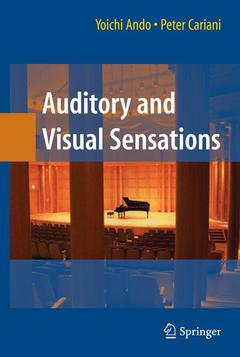Auditory and Visual Sensations, 2010
Auteur : Ando Yoichi
Coordonnateur : Cariani Peter

Yoichi Ando is an expert in the areas of concert hall acoustics architectural acoustics, brain activities, and environmental design. He has been awarded the AIA Institute Honor, American Institute of Architects in 1995: For 30 years of work developing and applying new theories of concert hall acoustics have helped the way music is heard. A scientist, author, and educator, his achievements are a benefit to both the world of architecture and the world of music. He has also been awarded the "Laurea Honoris Causa" (Dottore ad Honorem) by University of Ferrara, Italy on 12 June 2002, and serves as Editor-In-Chief, of the Journal of Temporal Design in Architecture and the Environment.
Peter Cariani works in the fields of auditory neurophysiology; temporal coding of pitch, timbre, and consonance; neural networks for temporal processing; music perception and cognition.
Date de parution : 10-2009
Ouvrage de 344 p.
15.5x23.5 cm
Thèmes d’Auditory and Visual Sensations :
Mots-clés :
Electronic and Magnetic Responses in the Central Auditory Sy; Neuroscience; auditory evoked potentials; concert; hoyingf; interaural crosscorrelation function; neurophysiology; perception acoustics; physiology; speech intelligibility; temporal autocorrelation function; theory subjective preference



